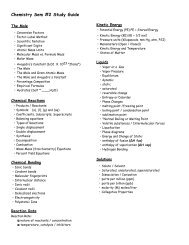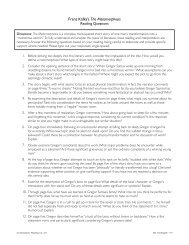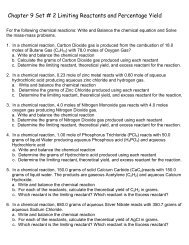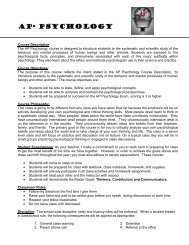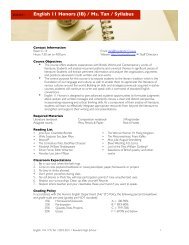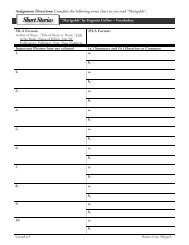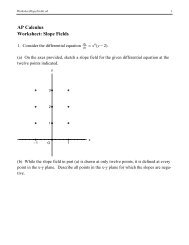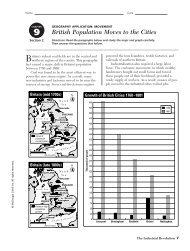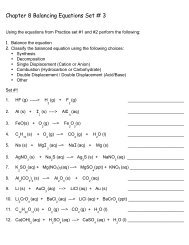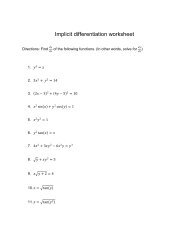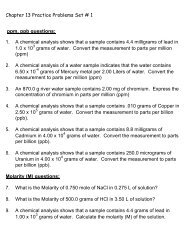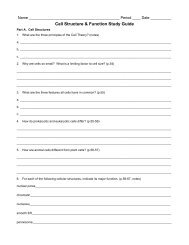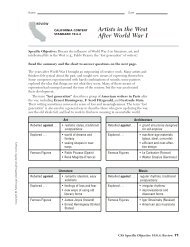Create successful ePaper yourself
Turn your PDF publications into a flip-book with our unique Google optimized e-Paper software.
Name________________________________Period_______Date___________Code______<br />
<strong>Diffusion</strong> and <strong>Osmosis</strong><br />
In Living Systems<br />
Introduction<br />
Substances that are dissolved in liquids produce solutions. These dissolved substances move into and out of<br />
the cells of living things. This movement is called diffusion; it is one of the main methods used by living<br />
things to maintain a steady state. <strong>Diffusion</strong> throughout a cell involves the movement of substances from a<br />
region of greater concentration to a region of lesser concentration. It is by this process that cells obtain the<br />
chemicals they need to carry on their work and to rid themselves of waste products.<br />
Objectives<br />
• Apply the principles of diffusion to explain observations made in basic diffusion experiments.<br />
• Explain the cause and effect of water gain or loss in a living cell.<br />
• Apply the principles learned in these experiments to other similar types of diffusion problems.<br />
Materials<br />
dialysis tubing (12 cm lengths) distilled water iodine (I-KI) solution (diluted)<br />
test tubes a large beaker 1% starch solution<br />
250 ml beakers slide 3% NaCl solution<br />
string coverslip 80% glucose solution<br />
hot plate living Elodea plants Benedict’s solution<br />
dropper<br />
Procedure<br />
<strong>Diffusion</strong> Through a Membrane<br />
In this experiment, the dialysis membrane<br />
represents the cell membrane. Though it is<br />
nonliving, it has several properties in common<br />
with a living membrane.<br />
1. Preliminary tests:<br />
Add a drop of iodine to 2 ml of starch<br />
solution in a test tube. Describe the<br />
reaction.<br />
____________________________________<br />
____________________________________<br />
Add 10 drops of Benedict’s solution to 5 ml of<br />
glucose solution in a test tube. Place the tube in<br />
boiling water for 3 minutes. Describe the<br />
reaction.<br />
_______________________________________<br />
_______________________________________<br />
_______________________________________<br />
The above tests will be used to determine the<br />
presence of starch and glucose in the diffusion<br />
experiment.<br />
____________________________________
7. Complete the chart indicating which<br />
materials have diffused and a brief<br />
supporting reason. Suggest a reason for<br />
the failure of some of the molecules to<br />
diffuse through the membrane.<br />
____________________________________<br />
2. Take a piece of dialysis tubing that has<br />
been soaking in water and rub it<br />
between the thumb and index finger<br />
until it opens. Using string, tie a knot<br />
very tightly at one end of the bag as<br />
shown in the picture.<br />
3. Fill the tube ½ full of starch solution<br />
and then add approximately 6<br />
dropperfuls of 80% glucose solution to<br />
it. Tie the open end of the bag and rinse<br />
the outside of the bag under a faucet.<br />
4. Place the bag in a 250 ml beaker and<br />
add only enough water to cover bag.<br />
Add enough iodine to the beaker to turn<br />
the contents light orange.<br />
5. Make observations of the bag and<br />
beaker contents for approximately 15<br />
minutes. The results of the preliminary<br />
tests should help you understand what is<br />
happening.<br />
6. After 15 minutes, place 5 ml of beaker<br />
fluid in a test tube. Add enough<br />
Benedict’s solution to turn the contents<br />
blue. Heat the test tube in boiling water<br />
for 3 minutes. Observe the reaction.<br />
____________________________________<br />
A membrane that allows some molecules to<br />
pass but not others is called:<br />
____________________________________<br />
Can materials diffuse through a membrane<br />
in both directions at the same time?<br />
Explain.<br />
____________________________________<br />
____________________________________<br />
____________________________________<br />
In what ways is the dialysis membrane like<br />
the cell membrane?<br />
____________________________________<br />
____________________________________<br />
____________________________________<br />
In each case, the molecules moved from<br />
__________ concentration to __________<br />
concentration.<br />
<strong>Diffusion</strong> through<br />
membrane?<br />
Experimental Evidence<br />
iodine<br />
starch<br />
glucose<br />
water
The Effect of <strong>Osmosis</strong><br />
On Living Cells<br />
1. This experiment is about the diffusion<br />
or osmosis of water. Prepare two wet<br />
mounts of elodea - one in pond water<br />
and the other in a 3% NaCl solution.<br />
Remember that 3% NaCl means 97%<br />
water. A typical elodea cell will<br />
contain about 1% salt.<br />
2. Examine the elodea in pond water under<br />
a microscope. Sketch and label some<br />
typical cells in the space provided in<br />
this activity. Describe the position of<br />
the chloroplasts in the cell.<br />
____________________________________<br />
____________________________________<br />
____________________________________<br />
3. Observe the salt water preparation and<br />
sketch the cells. What has happened to<br />
the location of the cell membrane and<br />
chloroplasts?<br />
____________________________________<br />
____________________________________<br />
____________________________________<br />
Has water moved in or out of the cell?<br />
____________________________________<br />
Explain the water movement in terms of<br />
concentration difference.<br />
____________________________________<br />
____________________________________<br />
____________________________________<br />
____________________________________<br />
4. Now, remove the coverslip and<br />
thoroughly rinse the elodea leaf under<br />
tap water. Prepare a new slide of the<br />
same leaf using distilled water. Look<br />
for changes in the cells.<br />
Sketch these cells below. Why did the cells<br />
change appearance?<br />
____________________________________<br />
____________________________________<br />
____________________________________<br />
____________________________________<br />
Elodea Cells<br />
Pond Water 3% NaCl Solution After adding distilled water
Analysis<br />
1. Why do molecules diffuse?_________________________________________________________<br />
__________________________________________________________________________________<br />
2. Why would molecules of a gas diffuse more rapidly than those of a liquid?___________________<br />
__________________________________________________________________________________<br />
3. The two circles A and B, represent cells and the dots are water molecules.<br />
Which sketch represents a fresh water cell that has just been placed in salt water?____________<br />
Which cell will expand?_______________<br />
Do any molecules move out of cell B? Explain.<br />
__________________________________________________________________________________<br />
4. In the third circle C, draw the distribution of water molecules of a cell in osmotic balance.<br />
5. The shrinkage of cytoplasm within a cell from diffusion is known as _______________________.<br />
How can this process be a disadvantage to a cell?___________________________________________<br />
__________________________________________________________________________________<br />
How would taking in too much water be a disadvantage to a cell?______________________________<br />
__________________________________________________________________________________<br />
6. A cell contains 3% salt and 97% water. How would this cell respond if placed in a distilled water<br />
solution?<br />
__________________________________________________________________________________<br />
In a 10% salt solution?________________________________________________________________<br />
7. From evidence obtained in this experiment, list three factors that determine whether a molecule<br />
will diffuse into a cell.<br />
__________________________________________________________________________________<br />
__________________________________________________________________________________



